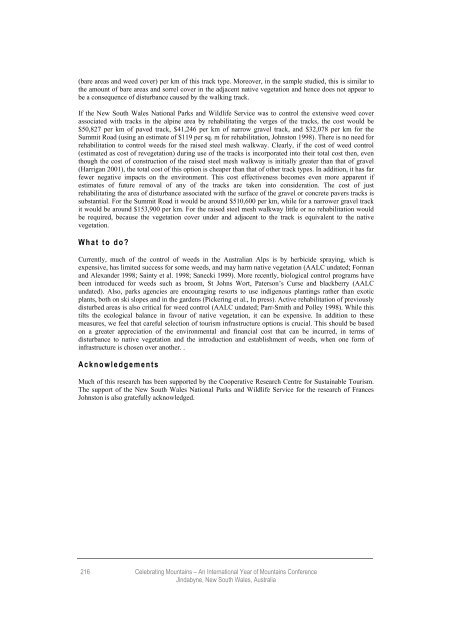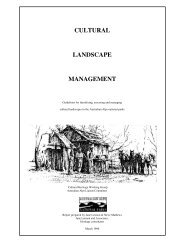(bare areas and weed cover) per km of this track type. Moreover, in the sample studied, this is similar tothe amount of bare areas and sorrel cover in the adjacent native vegetation and hence does not appear tobe a consequence of disturbance caused by the walking track.If the New South Wales <strong>National</strong> <strong>Parks</strong> and Wildlife Service was to control the extensive weed coverassociated with tracks in the alpine area by rehabilitating the verges of the tracks, the cost would be$50,827 per km of paved track, $41,246 per km of narrow gravel track, and $32,078 per km for theSummit Road (using an estimate of $119 per sq. m for rehabilitation, Johnston 1998). There is no need forrehabilitation to control weeds for the raised steel mesh walkway. Clearly, if the cost of weed control(estimated as cost of revegetation) during use of the tracks is incorporated into their total cost then, eventhough the cost of construction of the raised steel mesh walkway is initially greater than that of gravel(Harrigan 2001), the total cost of this option is cheaper than that of other track types. In addition, it has farfewer negative impacts on the environment. This cost effectiveness becomes even more apparent ifestimates of future removal of any of the tracks are taken into consideration. The cost of justrehabilitating the area of disturbance associated with the surface of the gravel or concrete pavers tracks issubstantial. For the Summit Road it would be around $510,600 per km, while for a narrower gravel trackit would be around $153,900 per km. For the raised steel mesh walkway little or no rehabilitation wouldbe required, because the vegetation cover under and adjacent to the track is equivalent to the nativevegetation.What to do?Currently, much of the control of weeds in the <strong>Australian</strong> <strong>Alps</strong> is by herbicide spraying, which isexpensive, has limited success for some weeds, and may harm native vegetation (AALC undated; Formanand Alexander 1998; Sainty et al. 1998; Sanecki 1999). More recently, biological control programs havebeen introduced for weeds such as broom, St Johns Wort, Paterson’s Curse and blackberry (AALCundated). Also, parks agencies are encouraging resorts to use indigenous plantings rather than exoticplants, both on ski slopes and in the gardens (Pickering et al., In press). Active rehabilitation of previouslydisturbed areas is also critical for weed control (AALC undated; Parr-Smith and Polley 1998). While thistilts the ecological balance in favour of native vegetation, it can be expensive. In addition to thesemeasures, we feel that careful selection of tourism infrastructure options is crucial. This should be basedon a greater appreciation of the environmental and financial cost that can be incurred, in terms ofdisturbance to native vegetation and the introduction and establishment of weeds, when one form ofinfrastructure is chosen over another. .AcknowledgementsMuch of this research has been supported by the Cooperative Research Centre for Sustainable Tourism.The support of the New South Wales <strong>National</strong> <strong>Parks</strong> and Wildlife Service for the research of FrancesJohnston is also gratefully acknowledged.216Celebrating Mountains – An International Year of Mountains ConferenceJindabyne, New South Wales, Australia
ReferencesAALC See <strong>Australian</strong> <strong>Alps</strong> Liaison Committee<strong>Australian</strong> <strong>Alps</strong> Liaison Committee (Undated). Weed Management Manual for the <strong>Australian</strong> <strong>Alps</strong><strong>National</strong> <strong>Parks</strong>. AALC, Canberra.Buckley, R. C., Pickering, C. M. and Warnken, J. (2000). Environmental management for alpine tourismand resorts in Australia. In: Goode, P. M., Price, M. F. and Zimmermann, F. M. (eds) Tourism andDevelopment in Mountain Regions. CABI Publishing. New York, pp. 27-46.Buckley, R. C., Weaver, D. and Pickering, C.M. (In press). Nature Tourism and the Environment. CABIPublishing, New York.Carr, G.W. Yugovic, J.V. and Robinson, K.E. (1992). Environmental Weed Invasions in Victoria:Conservation and Management Implications. Department of Conservation and Environment,Melbourne.COA See Commonwealth of Australia.Commonwealth of Australia (1999). The <strong>National</strong> Weeds Strategy: A Strategic Approach to WeedProblems of <strong>National</strong> Significance. COA, Canberra.Csurches, S. and Edwards, R. (1998). <strong>National</strong> Weeds Program, Potential Environmental Weeds inAustralia: Candidate Species for Preventative Control. Biodiversity Group, Environment Australia,Canberra.Eagles, P.F.J., McCool, S.F. and Haynes, C.D. (2002). Sustainable Tourism in Protected Areas:Guidelines for Planning and Management. Best Practice Protected Area Guidelines Services No. 8.World Commission on Protected Areas, International Union for the Conservation of Nature, TheWorld Conservation Union, Cambridge.Forman, R.T.T. and Alexander, L.E. (1998). Roads and their major ecological effects. Annual Review ofEcology and Systematics 29:207-31.Harrigan, A. (2001). Kosciuszko summit area track techniques. In: Walking Track Management FieldForum 26-29 March 2001. <strong>Australian</strong> <strong>Alps</strong> Liaison Committee, pp. 86-89.Hill, W. and Pickering, C.M. (Draft manuscript) Management issues associated with tourisminfrastructure: the effect of different walking track types on vegetation in the Kosciuszko alpine area,Australia.Johnston S.W. (1998). Marritz Precinct Plan. Perisher Village, Kosciuszko <strong>National</strong> Park: Principles andprocedures of soil restoration and native revegetation. NSW <strong>National</strong> <strong>Parks</strong> and Wildlife Service,Jindabyne.Johnston, F.M. and Pickering, C.M. (2001a). Alien plants in the <strong>Australian</strong> <strong>Alps</strong>. Mountain Research andDevelopment. 21 (3): 284-291.Johnston, F.M. and Pickering, C.M. (2001b). Yarrow, Achillea millefolium L.: a weed threat to the floraof the <strong>Australian</strong> <strong>Alps</strong>. Victorian Naturalist 118: 230-233.Low, T. (1999). Feral Future: The Untold Story of Australia’s Exotic Invaders. Viking Penguin Books,Melbourne.Celebrating Mountains – An International Year of Mountains ConferenceJindabyne, New South Wales, Australia217
- Page 2 and 3: 200Celebrating Mountains - An Inter
- Page 5: Cultural ContextThe southern margin
- Page 8 and 9: 206Celebrating Mountains - An Inter
- Page 10 and 11: Broom In The Australian Alps Introd
- Page 12 and 13: Tumut workshop The English broom wo
- Page 14 and 15: 212Celebrating Mountains - An Inter
- Page 16 and 17: Natural area tourismTourism is the
- Page 20 and 21: McDougall, K.L. and Appleby, ML. (2
- Page 22 and 23: As the demand for fresh water incre
- Page 24 and 25: Mountain Catchment Biomes As with m
- Page 26 and 27: ReferenceDavis, S.D., Heywood, V.H.
- Page 28 and 29: KNP Package, are designed to provid
- Page 30 and 31: General environmental managementFor
- Page 32 and 33: Former Snowy Scheme Sites The corpo
- Page 34 and 35: 232Celebrating Mountains - An Inter
- Page 36 and 37: Map 1 - The Main Range showing the
- Page 38 and 39: The freeze-thaw cycle also disturbs
- Page 40 and 41: the Main Range between Dead Horse G
- Page 42 and 43: The landscape has been stabilised,
- Page 44 and 45: Kosciusko State Park Trust, 1963. P
- Page 46 and 47: 244Celebrating Mountains - An Inter
- Page 48 and 49: ottom line approach whereby social,
- Page 50 and 51: Parks Victoria have a general “He
- Page 52 and 53: ReferencesConservation and Environm
- Page 54 and 55: over the past 200 years and a measu
- Page 56 and 57: During the 2000 ski season, approxi
- Page 58 and 59: Several studies have been undertake
- Page 60 and 61: Mt Hotham ResortA pilot ultrafiltra
- Page 62 and 63: REFERENCESJacangelo, J., Adham, S.
- Page 64 and 65: Kosciuszko National Park attracts a
- Page 66 and 67: improvements are ongoing. An EMS Op
- Page 68 and 69:
All stakeholders are responsible fo
- Page 70 and 71:
268Celebrating Mountains - An Inter
- Page 72 and 73:
market and invite feedback from the
- Page 74 and 75:
272Celebrating Mountains - An Inter
- Page 76 and 77:
foundation for a variety of income
- Page 78 and 79:
noted above, often visitors will re
- Page 80 and 81:
experiences that are provided are r
- Page 82 and 83:
Importance of Benefits by SegmentIm
- Page 84 and 85:
Literature CitedBorrie, W. T. and R
- Page 86 and 87:
simply not receiving the leaflets.
- Page 88 and 89:
5. American researchers had examine
- Page 90 and 91:
Formative EvaluationBetween Februar
- Page 92 and 93:
The two-part directive is short, al
- Page 94 and 95:
ReferencesAjzen, I., 1991, The Theo
- Page 96 and 97:
.294Celebrating Mountains - An Inte
- Page 98 and 99:
Within the CRC ST there are seven p
- Page 100 and 101:
SummerTourismSummerVisitor UsageAlp
- Page 102 and 103:
References AALC See Australian Alps
- Page 104 and 105:
LiteratureCumulative impacts (CI) a
- Page 106 and 107:
There are still conflicts in relati
- Page 108 and 109:
Some of the challenges inherent in
- Page 110:
Minichiello V, A. R., Timewell E, a
















